Venus is the hottest planet in our solar system. This hostile world is covered in thousands of volcanoes and is encased in a dense layer of toxic clouds, swept along by constant hurricane-force winds.
Explore facts about the planet closest to Earth.
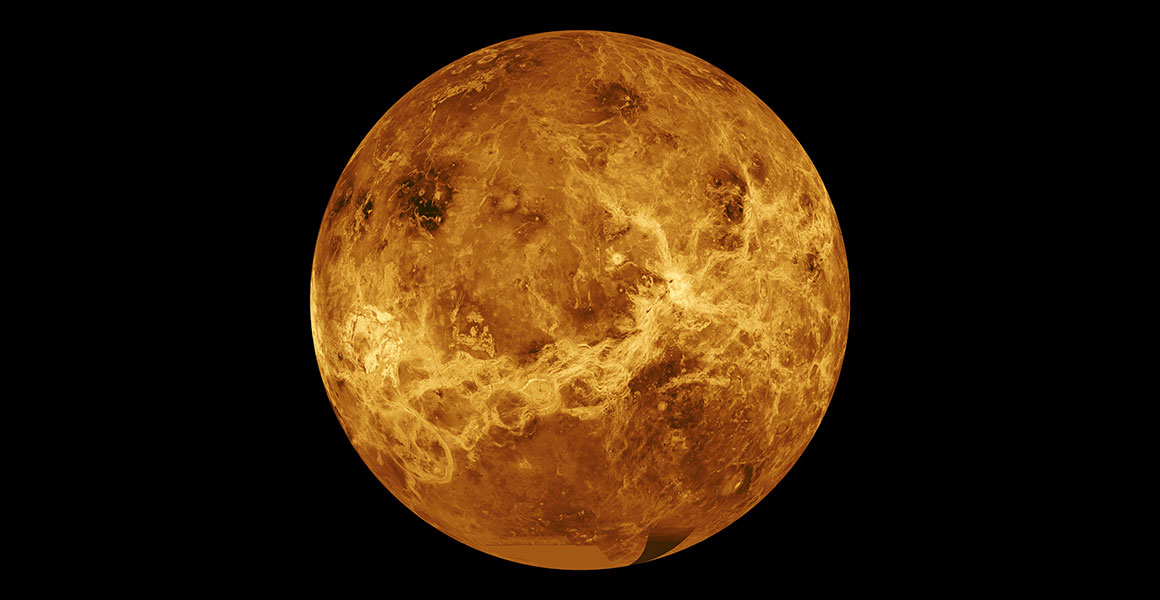
A computer-simulated image of the planet Venus, using images of the surface mapped by NASA's Magellan spacecraft. The colouration was based on images recorded by the Venera 13 and 14 spacecraft. © NASA/JPL
Venus is the hottest planet in our solar system. This hostile world is covered in thousands of volcanoes and is encased in a dense layer of toxic clouds, swept along by constant hurricane-force winds.
Explore facts about the planet closest to Earth.

Owing to similarity in size, mass and composition, Venus is sometimes called Earth's sister planet. With an equatorial circumference of 38,025 kilometres and radius of 6,052 kilometres, Venus is only marginally smaller than Earth.
Venus has an iron core around the same size as Earth's - approximately 3,000 kilometres in radius. But due to a weak magnetic field, which in part relies on convection in the core, it has been suggested that Venus's core may be predominantly solid.
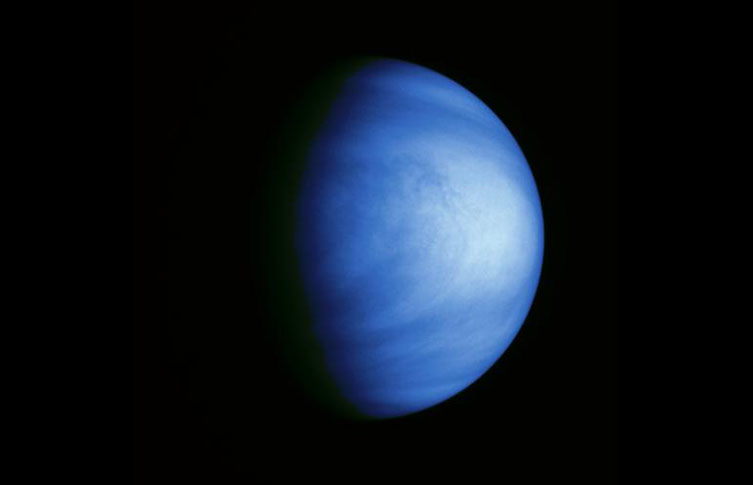
A colourised image of Venus taken by the Galileo Orbiter in 1990 from a distance of approximately 1.7 million miles. It was taken through a violet filter and colourised to a bluish hue, emphasising the subtle differences in the thick clouds. © NASA/JPL
Venus is the hottest planet in the solar system, sustaining an average surface temperature of 462°C, hot enough to melt lead.
The planet's dense atmosphere prevents the Sun's heat from escaping back into space, causing an extreme greenhouse effect. The temperature barely changes, neither from day to night nor between the poles and the equator.
Venus's extreme heat does not allow for water on the planet. The dry surface appears to be made of terrestrial-like basalt, a fine-grained volcanic rock.
But Venus may have been more habitable earlier in its history. For around two billion years the planet may have been covered in a shallow ocean and due to proximity to the Sun, the water evaporated. This caused carbon dioxide to build up in the atmosphere, which led to today's intense greenhouse effect.
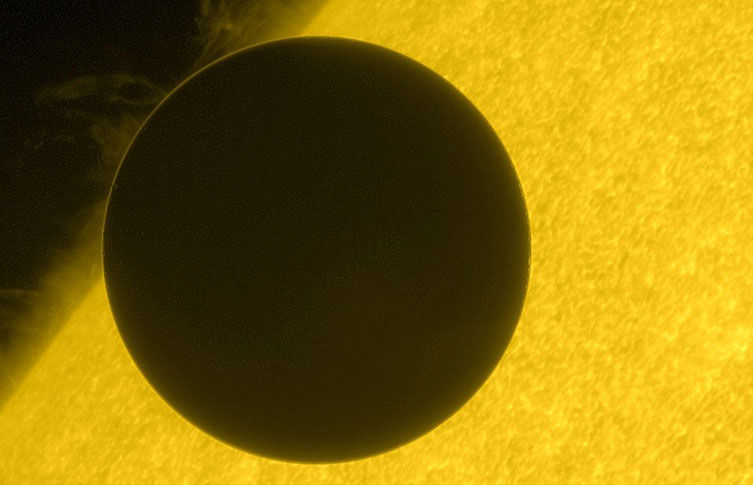
An image captured by the Hinode spacecraft of the 2012 transit of Venus © JAXA/NASA
Venus is the second planet from the Sun, orbiting at an average of 108 million kilometres from the star. Its orbit is the most circular of all the planets in our solar system - others take a more oval-shaped path around the Sun.
Venus is the closest planet to Earth. The closest point between the planets occurs once every 584 days, at 38 million kilometres.
A transit of Venus occurs when Venus passes directly between the Earth and Sun, appearing as a black disc tracking across the Sun.
Planetary transits are less frequent than eclipses. Transits of Venus are one of the rarest predictable celestial events. When one occurs, a second follows eight years later. The next will then occur either 105 or 121 years later, due to the orbital periods of both Earth and Venus - then the pattern repeats.
The most recent transits of Venus occurred in 2004 and 2012. The next will occur in December 2117.
The first scientifically recorded transit of Venus occurred in 1639, observed by English astronomers Jeremiah Horrocks and William Crabtree. In 1769, Captain James Cook's first voyage was one of five expeditions organised by the Royal Society to record a transit of Venus. Cook's HMS Endeavour crew viewed the event from Tahiti.

An artist's concept of lightning occurring in Venus's atmosphere © J. Whatmore via ESA Image Library
Venus rotates very slowly. It has the longest days of any planet in the solar system. A full rotation on its axis, also known as a sidereal day, takes 243 Earth days.
A year on Venus – the time it takes for the planet to make one full circuit around the Sun – lasts for 225 Earth days. This means that a sidereal day on Venus is longer than a Venusian year.
But a full solar day – the time taken for the Sun to return to the same place in the sky – on Venus lasts for only around 117 Earth days. This is shorter than a full rotation on its axis because the planet rotates very slowly in retrograde.
If viewed from their northern pole, most planets spin anticlockwise, but Venus rotates clockwise. On Venus, the Sun rises in the west and sets in the east.
It's thought that the planet rotated anticlockwise until a massive impact flipped it upside down, resulting in its opposite rotation direction.
A planet's tilt is one of the reasons that seasons occur. Venus is tilted around 3° on its axis, almost vertically, similar to Mercury. But as the planet is upside down, it is also considered tilted 177°. This means that there is very little distinction between seasons.
Venus has no moons or rings.
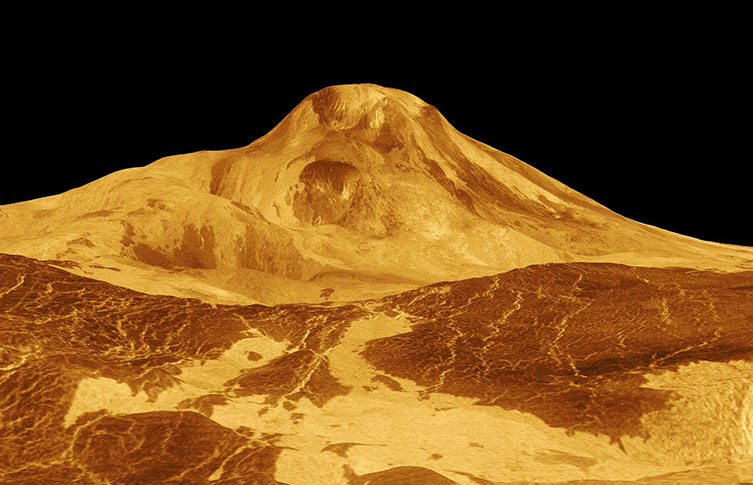
A computer simulated image of Maat Mons, the tallest volcano and second highest peak on Venus © NASA/JPL
Venus is a terrestrial planet like Earth, but life as we know it would not be able to survive there.
The atmosphere is made mainly of carbon dioxide and small amounts of nitrogen. The planet is encased in a layer of clouds that are up to 80 kilometres thick, made mostly of sulphuric acid and sulphur dioxide. The atmosphere combined with the extreme temperature and hurricane-force winds, moving at roughly 350 kilometres per hour, make Venus inhospitable.
Venus's atmosphere is dense and crushing. The pressure sustained on the planet is similar to what is experienced around one kilometre deep in Earth's oceans.
The planet has fewer impact craters than other celestial bodies, implying that the surface is young - estimated between 180 million and 800 million years old. Venus has the most volcanoes of any planet in the solar system, with thousands on its surface. Some researchers think resurfacing was caused by the entire planet being flooded with lava, whereas others suggest that it occurred over a prolonged period of volcanic activity.
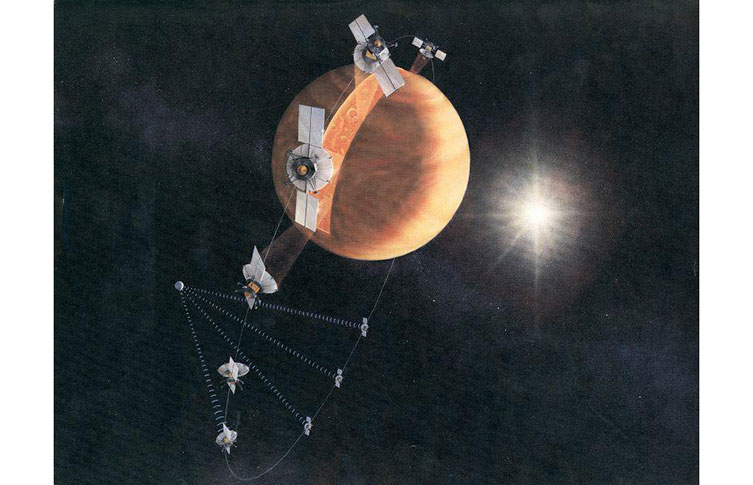
An artist's concept of NASA's Magellan spacecraft using radar to map the surface of Venus © NASA/JPL-Caltech
Venus is one of the five classical planets visible to the naked eye and the second brightest celestial object in the night sky - only the Moon outshines it. It isn't known who first recorded Venus, but it's named after the Roman goddess of love and beauty, making it the only planet in our solar system to be named after a female figure.
More than 40 spacecraft have visited Venus. The first was NASA's Mariner 2, which took basic measurements of the atmosphere - its launch and arrival happened in 1962. In 1989, NASA's Magellan was launched and used radar to map 98% of the planet's surface. This gave scientists their first look under Venus's thick cloud layer.
Venus's harsh atmosphere means that spacecraft don't last long on its surface. Venera 13, a probe from the former Soviet Union's Venera programme (1961-1984), has so far lasted the longest by functioning for just over two hours after landing. It provided some of the only photographs of the Venusian surface to date. The Russian space agency Roscosmos has proposed Venera-D, an orbiter and lander, being considered for launch in 2029 - although the mission is not yet confirmed.
The ESA's satellite Venus Express, which launched from Kazakhstan in 2005, was in operation for over eight years, far exceeding the initial planned life of around 500 Earth days. This spacecraft orbited the planet, conducting a comprehensive study of the atmosphere until it exhausted its fuel supply in 2014.
The most recent successful mission to Venus was JAXA's Akatsuki spacecraft. The probe flew past the planet in 2010 and failed to enter orbit. An attempt at re-entry was scheduled for 2015 and succeeded - Akatsuki is still in operation and gathering data on Venus's atmosphere.
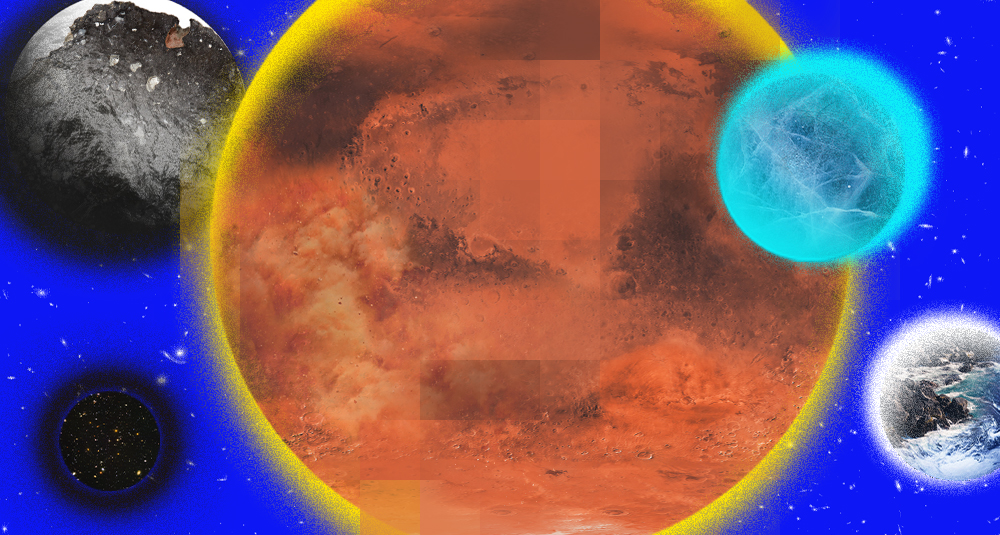
Find out in our latest exhibition! Snap a selfie with a piece of Mars, touch a fragment of the Moon and lay your hands on a meteorite older than our planet.
Open now

Discover more about the natural world beyond Earth's stratosphere.
Don't miss a thing
Receive email updates about our news, science, exhibitions, events, products, services and fundraising activities. We may occasionally include third-party content from our corporate partners and other museums. We will not share your personal details with these third parties. You must be over the age of 13. Privacy notice.
Follow us on social media